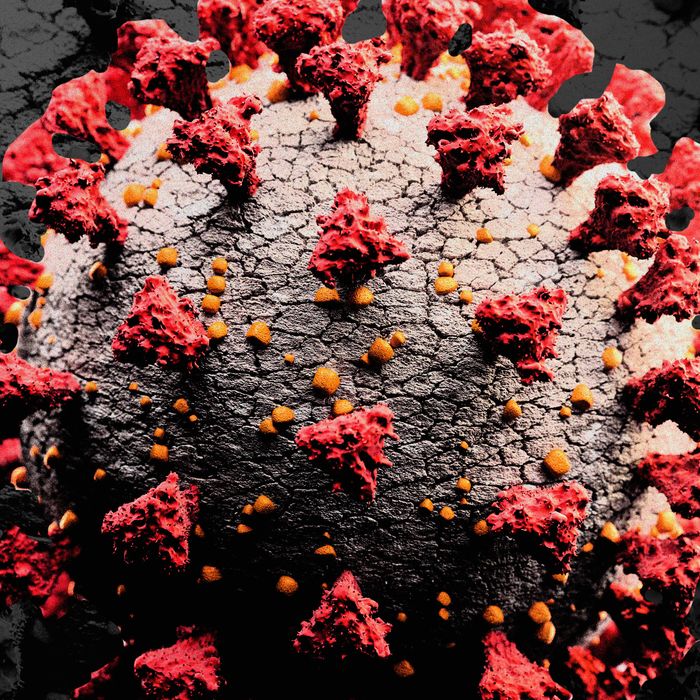
Photo-Illustration: Intelligencer; Photo: Getty
There is clear evidence that COVID-19 is on the rise in New York City, the U.S., and other places around the world, but the late-summer surge in cases, hospitalizations, and deaths is so far more like an uptick than a wave, and those numbers remain low. There’s also a new highly mutated variant called BA.2.86 on the scene and a newly updated COVID booster shot on the horizon. Below is what to know — and why not to panic — about the state of COVID as we head into the first fall and winter since the official end of the U.S. and global public-health emergencies over the coronavirus.
Though none are perfect, every available COVID metric, including wastewater monitoring and CDC data, indicates that cases have been rising across the country.
Even just anecdotally, it may seem like everybody once again knows somebody who has tested positive in recent weeks. But while COVID hospitalizations and deaths have been slowly creeping up, the numbers remain far below even past low points in the pandemic, and our multilayered wall of immunity from vaccination, boosters, and past infections continues to provide excellent protection against serious illness from COVID-19.
As always, the coronavirus continues to pose a higher threat to specific groups of people: seniors — who still make up the vast majority of deaths from COVID, and who remain undervaccinated in the U.S. — as well as people who are immunocompromised, pregnant women, and those who suffer from certain health conditions like chronic lung diseases. COVID also sadly remains one of the leading preventable causes of death in the U.S. — and will likely continue to be. In addition, for those who suffer from Long COVID, the search for answers continues to be painfully slow.
For anyone worried about the uptick, the same old tools — high-filtration face masks, good ventilation and air filtration, and avoiding crowded indoor spaces — remain just as effective against the virus as they always were. And again, for the vast majority of people who do catch COVID, their case will most likely be mild and uneventful, save for the disruption of canceled plans and feeling like crap.
Not really. In recent weeks, a handful of businesses, health-care institutions, and universities in parts of the country have temporarily reinstituted mask mandates because of locally rising COVID cases or detected outbreaks. But the widespread return of mask mandates is neither happening nor expected to happen, despite a rise in fear mongering over the matter from conservative influencers and GOP lawmakers — including former president Donald Trump.
The most recent variants to gain dominance in the U.S. and globally, XBB.1.5 and EG.5, have not constituted significant evolutions of the coronavirus or major new threats. But there is a newly detected variant, BA.2.86, that is drawing attention from scientists and public-health experts on account of the more than 30 new mutations it has on its spike protein and how they might help it evade prior immunity. BA.2.86 has already been detected in multiple countries, including a handful of cases in the U.S. — though U.S. and global variant surveillance is nowhere near as comprehensive as they used to be. There have been some alarming headlines about BA.2.86, but the bottom line is that scientists are still studying the new variant, and it’s not wholly clear what impact it will have. As has been the case with previous newcomers in the Omicron lineage, it seems highly unlikely that the variant will trigger more severe illness. It’s not yet clear if it will be more infectious.
Whether it becomes a big deal globally or not, BA.2.86 demonstrates that the coronavirus is still capable of making significant evolutionary leaps out of what seems like nowhere. That’s not good, and COVID experts like Scripps’ Eric Topol continue to worry that it’s just a matter of time until another Omicron-like whammy:
Even if BA.2.86 doesn’t pose a real threat by virtue of low transmission, or its further evolution proves to be relatively benign, the fact that the inexorable evolution of the virus continues — to find new hosts and repeat hosts — cannot be ignored. If this isn’t “the one,” it ought to signify that “the one” is still yet to come. If it never shows up, that’s great. But you sure don’t want to bet on that. All of us wish this was behind us, but it’s not. Facing that fact this virus, in one version or another, will be with us for many years to come, rather than denialism and complacency, is critical.
At the moment, there’s no reason for alarm. The current wavelet in the U.S. (which could certainly pick up steam) is not likely driven by the XBB descendants of EG.5.1 or FL.1.5.1. (More likely an outgrowth of waning immunity and behaviors.) We know well the mitigating factors that work against all respiratory viruses. What we’ll see in the weeks ahead is whether BA.2.86 takes hold or not. If it does, that will pose a new challenge, and make the “updated” booster shots considerably less helpful than what was conceived when XBB.1.5 was selected as the target.
The Biden administration is soon expected to roll out a newly updated booster shot that was reformulated earlier this year to target the then-predominant XBB.1.5 variant. The exact arrival date remains unclear, but the new shots could become available as soon as in the coming weeks. All of this is consistent with the administration’s plan to offer a single annual COVID booster shot to bolster Americans’ protection, though public uptake of last year’s new bivalent booster fell far short of what public-health officials had hoped for.
This post has been updated.
"about" - Google News
August 31, 2023 at 11:52PM
https://ift.tt/1V8xgcW
What to Know About the New COVID Mini-Wave - New York Magazine
"about" - Google News
https://ift.tt/Y124jtR
Bagikan Berita Ini















0 Response to "What to Know About the New COVID Mini-Wave - New York Magazine"
Post a Comment